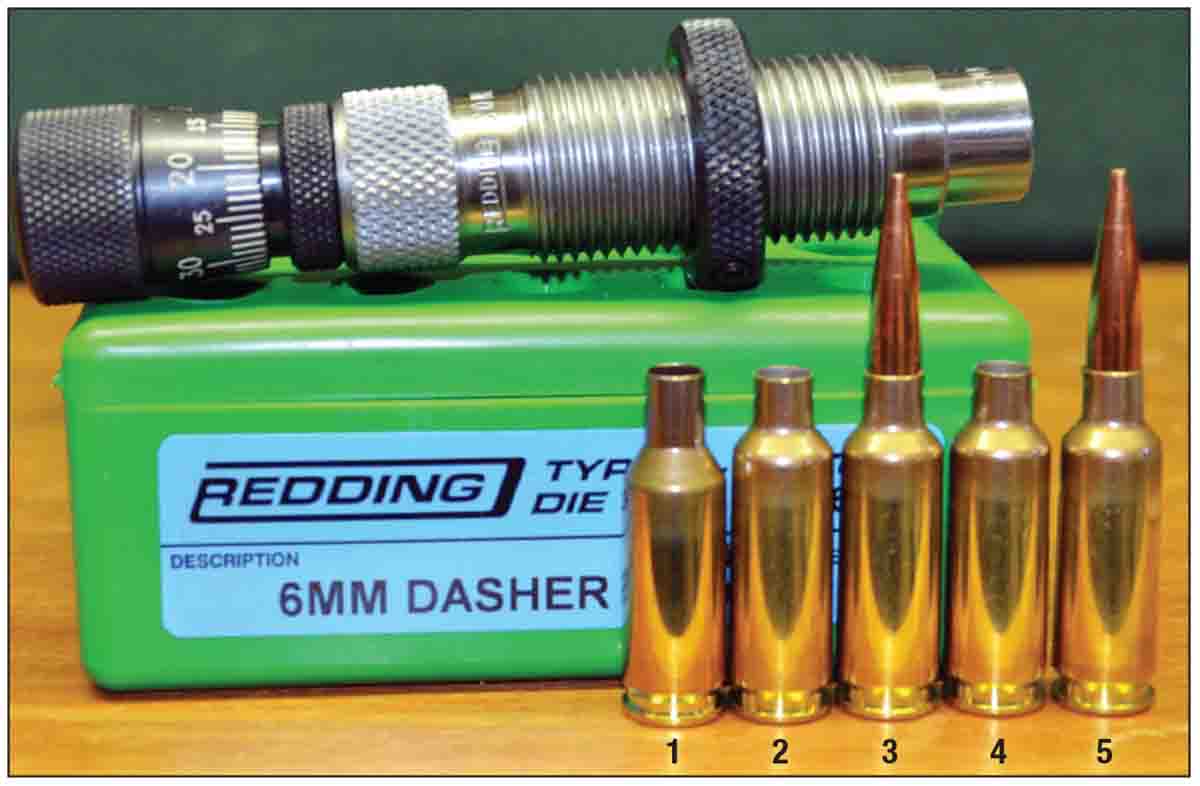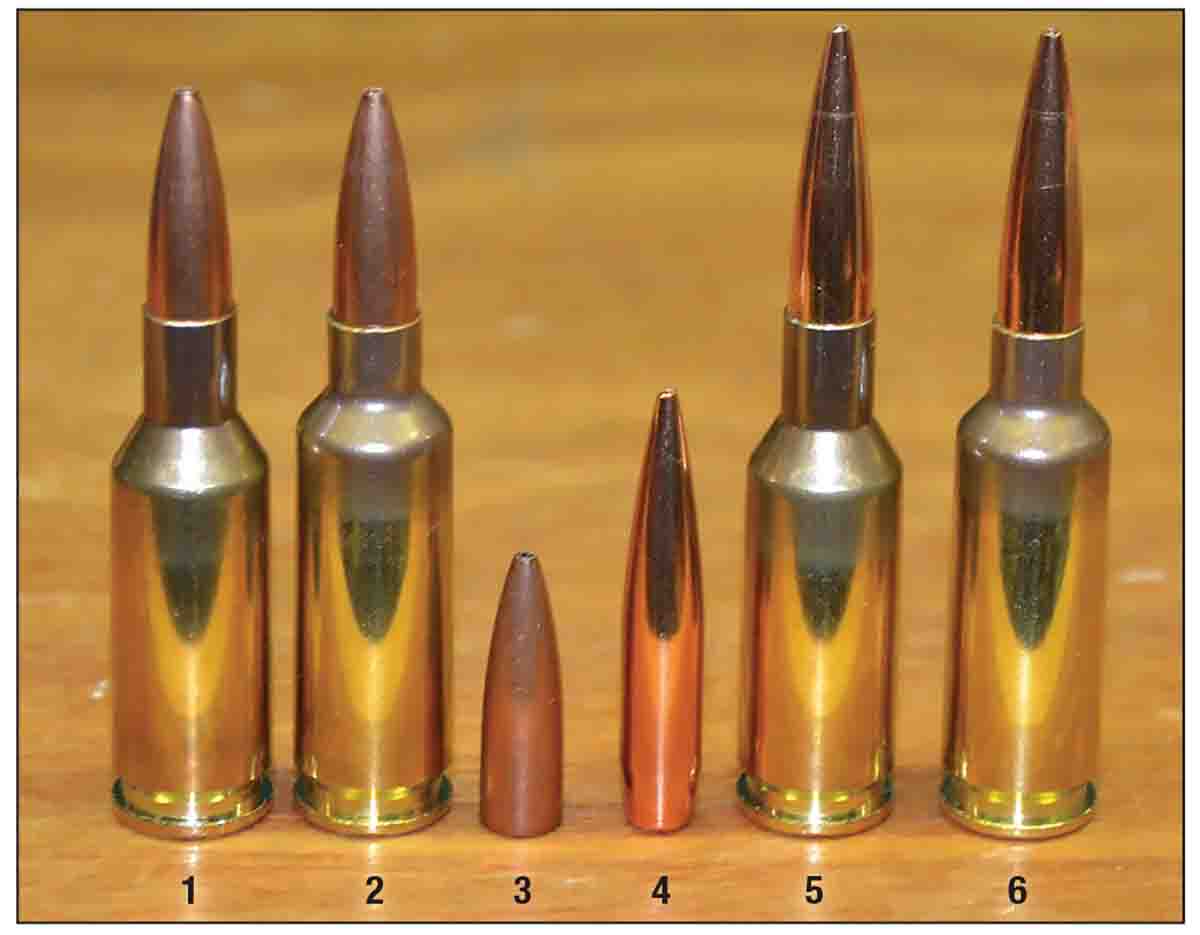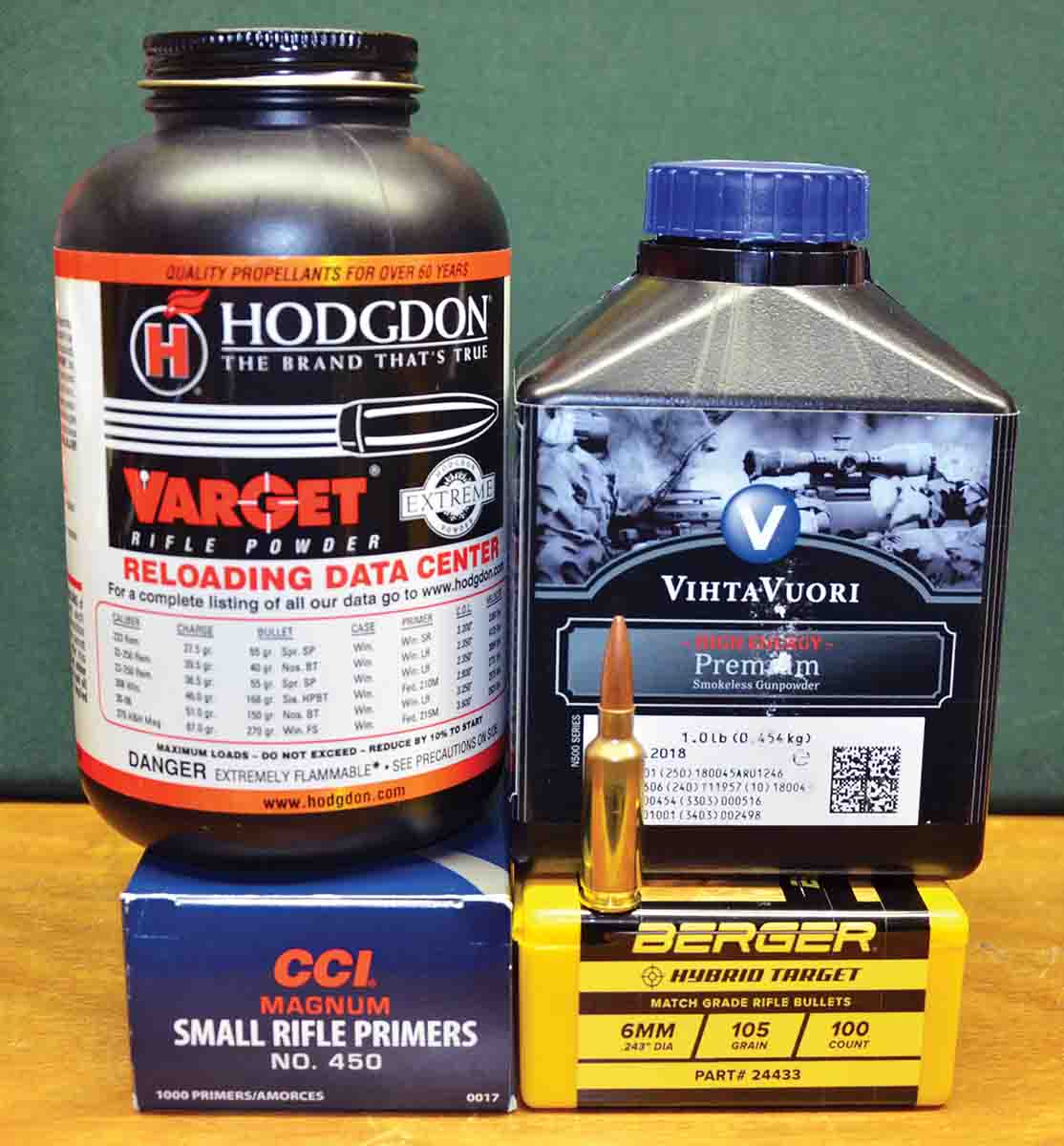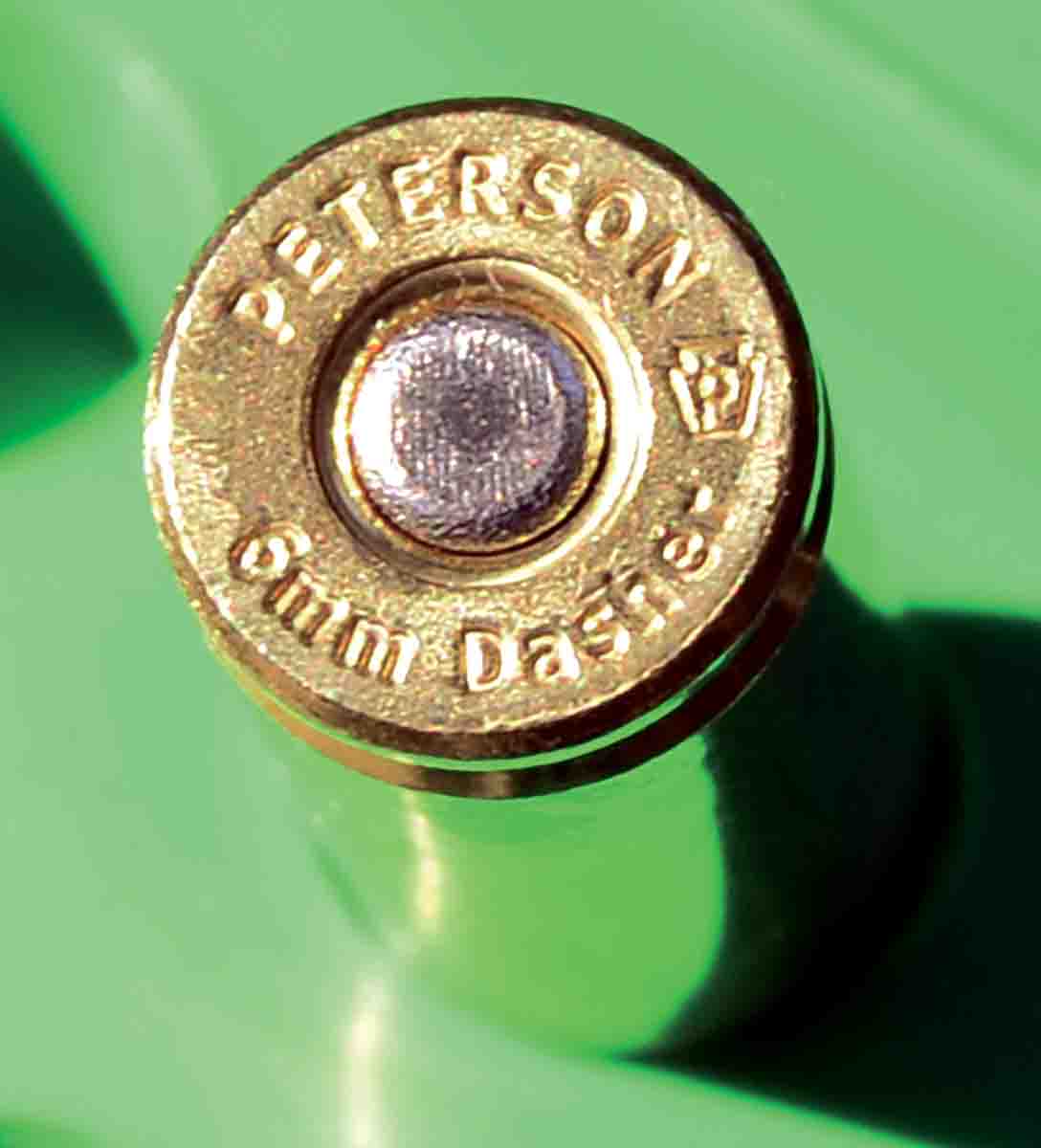The 6mm Dasher was developed in 1999 by Dan Dowling and Al Ashton for 100- and 200-yard benchrest competition. Its name was derived from the names “Dan” and “Ashton.” The 6mm Dasher is basically the earlier 6mm BR Remington case with its shoulder moved forward .120 inch or so for about 8 percent gain in capacity while the shoulder angle is increased from 30 to 40 degrees.
To be clear, dimensions for the 6mm BR case introduced by Remington in 1978 and the 6mm BR Norma case made by Lapua today are exactly the same. The difference is in chamber throat lengths of the rifles for which they are chambered. The 6mm BR chamber was originally throated for short bullets weighing from 60 to 70 grains while the 6mm BR Norma is throated long for bullets weighing up to 115 grains.

Kenny Jarrett built the test rifle around a blueprinted Remington 40XB single-shot action during the 1980s. Its two Hart barrels in 6mm BR Remington had a 1:14 twist and were quite accurate with Hodgdon’s H-322 and 68-grain bullets made by Allie Euber. A 1:7.5 twist Shilen barrel in 6mm Dasher throated for the Berger 105-grain Hybrid Target bullet added later is equally accurate.
While the 6mm Dasher never proved to be a serious threat to 6mm PPC dominance in what is known today as short-range benchrest competition. It and other members of the 6mm BR family are extremely popular in Precision Rifle Series (PRS) competition where steel targets are engaged out to 1,000 yards and sometimes beyond. Low recoil, exceptional accuracy, acceptable barrel accuracy life and the ability to drive bullets of extremely high-ballistic coefficients to reasonable velocities make them ideal for the sport.
It is difficult to determine which of four 6mm BR family members is the most popular as each continues to win its share of long-distance matches. Some prefer the 6mm BR Norma, while others shoot the 6mm BRA, which is an improved version with less case body taper but with the same 30-degree shoulder. The 6mm BRX is formed by moving the shoulder .100 inch forward and it also retains the 30-degree shoulder. As already mentioned, the shoulder of the 6mm Dasher is moved forward .120 inch with its angle increased to 40 degrees.

The 6mm Dasher case is commonly fireformed from Lapua 6mm BR Norma brass, but that step is eliminated by using fully-formed 6mm Dasher cases from Peterson Cartridge. Shown above are: (1) a Lapua 6mm BR Norma case, (2) a Lapua case fireformed to 6mm Dasher shape, (3) a loaded 6mm Dasher round, (4) a Peterson fully-formed 6mm Dasher case and (5) a loaded 6mm Dasher round.
Many long-distance records have been made and broken by the 6mm BR variations and here are a coupleof impressive examples. During a 2013 International Benchrest Shooters (IBS) match at 600 yards, Rodney Wagner used a 17-pound Light Varmint class rifle in 6mm Dasher to shoot a five-shot group officially measured at an astounding .336 inch. To put that into perspective, the diameter of a new dime is .705 inch. Wagner seated CCI 450 Magnum Small Rifle primers in cases fireformed from Lapua 6mm BR Norma brass and seated the Berger 108-grain VLD Match Target bullet atop 32.5 grains of Varget. Breezes were gusting up to 10 mph and as is customary in benchrest competition, he waited until wind flags were indicating his chosen condition and then launched five bullets in about 12 seconds. Many believed the record would never be broken, but in 2018, Bart Sauter used a Light Varmint rifle in 6mm BRA to shoot five of his own 105-grain bullets into a .311-inch group at 600 yards.
Prior to the availability of pressure-tested load data in the Berger Reloading Manual (2012), the 2022 Hodgdon Annual Manual and the Lyman 51st Edition Reloading Handbook, also published in 2022, those who had rifles in 6mm Dasher were on their own when developing loads for them. Maximum chamber pressure published by Hodgdon is 52,600 CUP for a maximum velocity of 2,978 feet per second (fps) with a 107-grain bullet from a 30-inch pressure barrel. The highest velocity attained with that bullet was with IMR-4064, although velocity with all seven propellants tested exceeded 2,900 fps. Moving on up in bullet weight, the Berger manual shows a velocity of 2,786 fps for the 115-grain VLD Target with a maximum charge of W-760/H-414. The barrel length was 24 inches.

When introduced in 1999, the 6mm Dasher case was formed from 6mm BR Remington brass and bullets weighing from 60 to 70 grains were loaded in both. Then came long-distance competitive shooting and they were loaded with much heavier bullets: (1) a 6mm BR with Euber 68-grain hollowpoint, (2) a 6mm Dasher with Euber 68-grain hollowpoint, (3) a Euber 68-grain hollowpoint, (4) a Berger 105-grain Hybrid Target, (5) a 6mm BR with Berger 105-grain Hybrid Target and (6) a 6mm Dasher with Berger 105-grain Hybrid Target.
The Lyman manual credits IMR-4064 with producing the best accuracy with a 107-grain bullet at a velocity of 2,974 fps from a 24-inch barrel. Maximum charge weight is 1.1 grains lighter than in the Hodgdon manual. Behind the Berger 115-grain VLD Target, Lyman shows IMR-4064 producing the highest velocity at 2,901 fps, although Reloder 15 delivered the best accuracy at 2,849 fps. RL-15 was also the most accurate with the Berger 105-grain Hybrid Target.
While that information might be interesting, powders and bullets used by the majority of top-ranked Precision Rifle Series and National Rifle League competitors might be more useful. According to the results of a survey made by Cal Zent, among more than 75 world-class PRS and NRL shooters and posted in his always-informative Precision Rifle Blog, the majority used Hodgdon Varget powder. The 6mm Dasher uses a small rifle primer with the CCI 450 Magnum, the most popular by an extremely large margin. The primary reasons given for using it are lower velocity spread and standard deviation than with standard-force primers. The Berger 105-grain Hybrid Target was the most popular bullet. While that information was published by Zent in 2019, his survey results seem to hold true today.
The test rifle featured in this column has a bit of history. Built by Kenny Jarrett on a blueprinted, single-shot Remington 40-XB action during the early 1980s, it was originally in 6x47mm and later rebarreled for the 6mm BR Remington. This was before Jarrett started making his own barrels, so a pair of Hart barrels in Light Varmint and Heavy Varmint weights, both with a 1:13.5 twist, were used. Chamber neck diameter is .261 inch. A Davidson action wrench and a compact barrel vise made barrel-switching a five-minute job during a match. The action was glued into the fiberglass stock with the barrels freefloated. The rifle loved Vihtavuori N-133 powder and 68-grain bullets made by Allie Euber, legendary Hall of Fame benchrest shooter and all-around good guy.

According to a Cal Zent – who surveyed around 75 world-class PRS and NRL competitors – the CCI 450 Magnum primer, Hodgdon Varget powder and the Berger 105-grain Hybrid Target are the most popular. Vihtavuori N-540 is also an excellent choice.
When later deciding to try the 6mm Dasher, I rounded up a supply of Lapua 6mm BR Norma cases and added a 23-inch Shilen Select Match grade stainless steel barrel with 1:7.5 twist for the rifle built by Jarrett. The barrel diameter is 1.220 inches at the receiver and .935 inch at the muzzle. The chamber is throated specifically for the Berger 105-grain Hybrid Target, although other bullets can be used. The chamber neck diameter of the barrel is .271 inch. Neck diameter of the Lapua case with a .224-inch bullet seated ranges from .2685 to .2692 inch, so outside-turning to .268 inch improves uniformity. A Redding Type S die with a .266-inch bushing is used for neck-sizing cases. When case fit becomes a bit too tight after several firings, a Redding body die is used to bump back the shoulder .002 inch. With a Nightforce 12-42x 56mm scope in Talley tactical rings and Picatinny base, the rifle weighs a couple ounces over 12 pounds.
Anyone who buys a used rifle in 6mm Dasher should take note of its chamber neck diameter because it can vary considerably. Some will be small enough to require case neck turning while others will have “no-turn” chambers. The gunsmith who built the rifle may have stamped chamber neck diameter on the barrel, but if not, a Cerrosafe casting of the chamber will reveal that information.
When fireforming Lapua 6mm BR Norma brass for a 6mm dasher chamber, cases first go through a Redding Type S neck-sizing die with a bushing .004 inch smaller than the neck diameter of a loaded round. Using a bushing that small increases case neck tension on the bullet. The case is primed and charged with 29 grains of Varget. A 105-grain bullet is then seated out for hard engagement with the rifling when the loaded round is chambered. Firing produces a 6mm Dasher case. The case can also be hydraulically formed with a custom die from Hornady.

Fully-formed 6mm Dasher cases made by Peterson Cartridge are of excellent quality and last for many firings.
Forming is eliminated by using 6mm Dasher cases from Peterson Cartridge. On a Lyman digital scale, average weight of the Lapua case is 9 grains lighter, indicating slightly thicker brass in the Peterson case. That reduces its gross water capacity by 1.2 grains, which means that .2 grain less Varget produces the same velocity from my rifle. Regardless of which case is used, accuracy of rifle is the same. With the bullet seated, the neck diameter is the same as for the Lapua case, so it also is turned to .268 inch. The .066-inch flash holes of both cases require the use of a small decap pin. I have used Lapua and Peterson cases enough to become convinced they are equal in quality and service life. Choosing between the two boils down to which is available when a fresh supply of brass is needed.
.jpg)





.jpg)


